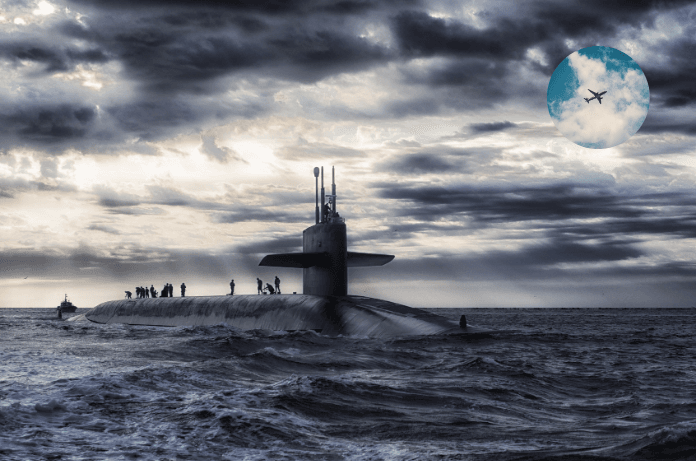Imagine an aircraft soaring 5,000 meters above the ocean, completely unaware that it’s being watched and not by another plane, or satellite but with submarine sensors 1,000 meters deep in the sea. Sounds like something out of a sci-fi movie, right? Well, China has made it a reality.
A team of Chinese researchers, led by Zhang Bo and Peng Zhaohui from the Institute of Acoustics at the Chinese Academy of Sciences, has achieved what was once thought to be impossible. Their breakthrough allows an underwater acoustic sensor array to detect and track high-altitude aircraft, potentially reshaping maritime conflicts forever.
This new technology could turn the tables in anti-submarine warfare (ASW), giving China a significant advantage over rival navies.
But how does it work, and what does it mean for the future of military strategy? Let’s break it down.
How Does It Work?
Traditionally, detecting aircraft from underwater has been a major challenge. Why? Because sound waves from airplanes barely penetrate the ocean. Most of them reflect off the surface, making it nearly impossible for submarines or underwater sensors to pick up signals.
However, Zhang and Peng’s team discovered a clever workaround. They realized that some sound waves, after hitting the seabed, bounce back toward the surface and then return to the depths. By capturing these weak signals and processing them intelligently, they managed to track aircraft flying high above.
This wasn’t easy. The signals get distorted as they pass through different layers of seawater, which have varying salinities, densities, and temperatures. Additionally, natural ocean currents and turbulence add to the noise, making it even harder to extract useful data.
To solve this, the researchers leveraged a little-known physical characteristic of underwater sound waves, filtering out false signals and improving accuracy. Their breakthrough was tested in 2022 when they successfully tracked an aircraft within 17 kilometers (10.5 miles) of their deep-sea radar with a margin of error of less than 1 km; all within a matter of seconds.
Why Does This Matter?
This development has huge implications for modern warfare, particularly anti-submarine operations. In naval battles, aircraft equipped with advanced sonar and torpedoes can easily hunt down submarines, putting them at a major disadvantage.
With this deep-sea radar, however, submarines could now detect enemy aircraft long before they come into range. This could allow them to take evasive action, launch counterattacks, or even fire missiles from underwater with greater precision.
In essence, submarines could go from being the hunted to the hunters.
Challenges and Limitations
While this technology is groundbreaking, it’s not perfect yet. The 2022 tests revealed some key limitations:
- Detection Range – The maximum detection range is less than 20 km, which is still too short for large-scale military operations.
- Blind Spots – Aircraft flying directly above the sensor array can’t be detected.
- Signal Interference – Reflected signals sometimes overlap with direct signals, causing accuracy issues.
Zhang and Peng acknowledged these challenges and are working on improving the technology. Though they haven’t shared newer results, it’s safe to assume that China has continued refining the system since the initial tests.
China’s Expanding Surveillance Network
China isn’t relying solely on this underwater radar for defense. The country has developed a global satellite network capable of tracking high-speed aircraft, including stealth fighters like the F-22. Additionally, China’s warships and land-based radars are equipped with long-range detection systems.
By integrating these technologies, China is moving toward a system-based warfare approach, where multiple surveillance methods work together to improve accuracy, survivability, and operational effectiveness.
This is a significant leap forward, and it raises an important question: How will other nations respond?
The Global Impact
At present, no other country has publicly disclosed having similar underwater detection capabilities. If China continues to refine this technology, it could shift the balance of naval power, particularly in regions like the South China Sea reported SCMP.
Other military powers, including the United States, Russia, and NATO allies, are likely to take this development seriously. If China achieves a longer detection range and eliminates blind spots, it could gain a major strategic advantage in maritime battles.
Nations that depend on aircraft for anti-submarine warfare may need to rethink their strategies, potentially investing in stealthier aircraft, counter-detection technologies, or their own seabed-based sensor networks.
Looking Ahead:
While China has made a major breakthrough, this is just the beginning. The technology still needs improvements before it becomes a game-changer in real combat. However, given China’s aggressive approach to military innovation, we can expect rapid advancements in the coming years.
If the detection range increases beyond 50 or 100 kilometers, this could revolutionize submarine warfare and intelligence gathering. China’s rivals will be watching closely, and we may soon see a new global arms race centered around underwater detection technology.
For now, the deep-sea radar remains one of the most fascinating technological developments in modern military science. Whether it becomes a true game-changer or just another tool in China’s defense arsenal remains to be seen.

